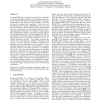185 search results - page 3 / 37 » Techniques for Enhanced Physical-Layer Security |
ACSW
2006
13 years 7 months ago
2006
Current IEEE 802.11 wireless networks are vulnerable to session hijacking attacks as the existing standards fail to address the lack of authentication of management frames and net...
JCM
2007
13 years 5 months ago
2007
— The use of signal processing techniques to protect wireless transmissions is proposed as a way to secure wireless networks at the physical layer. This approach addresses a uniq...
ICPR
2010
IEEE
13 years 3 months ago
2010
IEEE
In this article, a new fragile, blind, high payload capacity, ROI (Region of Interest) preserving Medical image watermarking (MIW) technique in the spatial domain for grayscale med...
GLOBECOM
2006
IEEE
13 years 11 months ago
2006
IEEE
— Enhanced Data Rates for Global Evolution (EDGE) based systems are expected to facilitate the same services as third generation WCDMA systems. This goal is achieved through phys...
WISEC
2010
ACM
13 years 5 months ago
2010
ACM
Physical-layer identification of wireless devices, commonly referred to as Radio Frequency (RF) fingerprinting, is the process of identifying a device based on transmission imperf...

